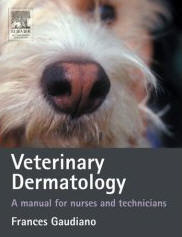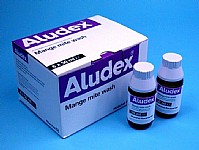| |
Common ectoparasite-related problems...
 Would
you believe that 36% of general veterinary practice cases are skin cases. Therefore, it is very
likely that at least one of your dogs will suffer from a skin problem sometime in its life.
Having a bit of knowledge about canine skin problems can help you help your vet come to a
speedy diagnosis and resolution of the problem. Clinical Trials Nurse Frances Gaudiano deals
with dermatological problems on a daily basis and has written this short article to help you
identify those little buggers... Would
you believe that 36% of general veterinary practice cases are skin cases. Therefore, it is very
likely that at least one of your dogs will suffer from a skin problem sometime in its life.
Having a bit of knowledge about canine skin problems can help you help your vet come to a
speedy diagnosis and resolution of the problem. Clinical Trials Nurse Frances Gaudiano deals
with dermatological problems on a daily basis and has written this short article to help you
identify those little buggers...
The most common skin problems are
parasite related. Luckily, we are now blessed with a armoury of safe and effective flea
products. If your dog has sensitive skin, it is recommended that you treat it for ectoparasites
all year round and not just in the summer. In addition, you need to treat your home, car and
anywhere else your dog hangs out (including the caravan) with a premise spray. Good premise
sprays only need to be used once a year but make sure you are following the manufacturer’s
guidelines regarding how much spray is needed per area.
 Control Control
In terms of ectoparasite control, you need to choose the product that is appropriate
for your area. If you live in an area where there are a lot of foxes, Stronghold is a
good choice because it is effective against sarcoptic mange (fox mange) as well as fleas. In
addition, Stronghold treats for heartworm, so if you plan to compete in mainland European
competitions, you will need this cover as well.
If ticks are a major problem, you might
want to try the new product Advotix which protects against fleas, ticks, mosquitoes and
sandflies. Again, this is a good product for those dogs planning to compete internationally.
 Treatment Treatment
Frontline is an excellent flea treatment as it is effective against adult fleas
while also interrupting the life cycle of the flea by making fleas infertile. This helps with
environmental control. Frontline spray is great to have around the house to spray on ticks for
quick removal. If your dog is treated, the ticks will fall off eventually, but if you are like
me, you want the tick off immediately. Spray it with frontline, wait 10minutes and the tick
will fall away as you pull it off with tweezers. Ticks should be removed promptly because the
longer they are attached to your dog, the longer they can transmit dangerous diseases, such as
Lyme’s disease. This disease causes arthritis, which would be particularly tragic for an
agility dog.
Frontline spray is also recommended for
the surface mite, Cheyletiella. This mite is known as ‘walking dandruff’ and is often
misdiagnosed as scurf. If you notice a sudden onset of dandruff and your dog seems itchy,
insist that your vet do a Tapestrip test to look for this mite. It can easily be eliminated
with Frontline spay. Sorry, the spot-on isn’t effective for this mite. Make sure you use the
correct numbers of pumps of the spray. Many people don’t realize that you need to use 2-4 pumps
per kilogram on your dog and end up under-treating, and leaving many mites alive.
If you live in an area with chalky
downs, your dog may be plagued with harvest mite between the toes and on the ear flaps. The
best treatment for harvest mite is Frontline spray. If you don’t want to spray the ears -
awfully near the eyes! - put the spray on a cotton ball and wipe the ears with the Frontline.
 Demodex
is a much less common mite. Dogs with demodex often have bald rings around their eyes that look
like spectacles. Some dogs lose hair on their feet, hocks and forelegs and develop a beet-red
colour to their skin. Puppies are more likely to be infested with demodex but will
outgrow it with benign neglect. However, adult dogs do need to be treated for demodectic mange.
Formerly, the treatment involved dipping your dog in a smelly mixture of Aludex.
However, there is a new spot-on on the market called, Advocate that is licensed for the
treatment of demodicosis. Please note that sarcoptic (fox) mange is contagious to people but
demodectic mange is not. Demodectic mange does not cause the dog to be nearly as itchy as
sarcoptic mange. Demodex
is a much less common mite. Dogs with demodex often have bald rings around their eyes that look
like spectacles. Some dogs lose hair on their feet, hocks and forelegs and develop a beet-red
colour to their skin. Puppies are more likely to be infested with demodex but will
outgrow it with benign neglect. However, adult dogs do need to be treated for demodectic mange.
Formerly, the treatment involved dipping your dog in a smelly mixture of Aludex.
However, there is a new spot-on on the market called, Advocate that is licensed for the
treatment of demodicosis. Please note that sarcoptic (fox) mange is contagious to people but
demodectic mange is not. Demodectic mange does not cause the dog to be nearly as itchy as
sarcoptic mange.
 About
the author... About
the author...
Frances Gaudiano is a clinical trials nurse at the Royal Veterinary College
in Hertfordshire. She has written a book on dermatology for veterinary nurses and the nose of
one of her dogs is on the cover of the book.
Frances competes with a Border Terrier
who does not have skin problems but could do with a personality transplant. (But she loves him
anyway!)
| |
|